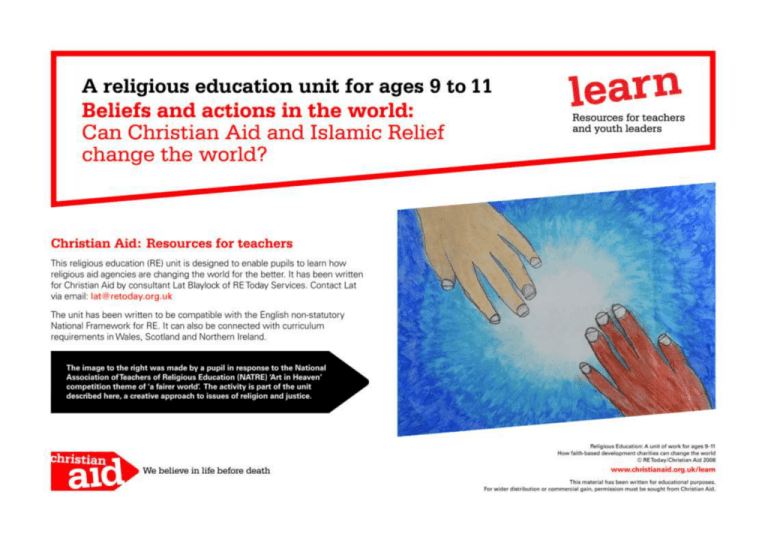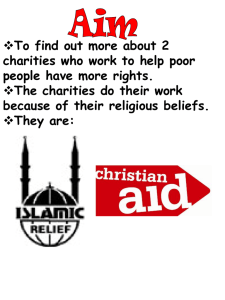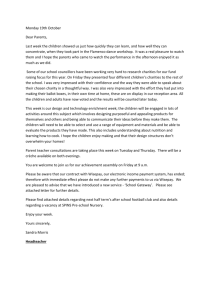RE Today teaching unit - Christian Aid : Learn
advertisement

What do we know about charities already? Learning objectives Teaching and learning Learning outcomes Points to note Pupils should learn to: What do we know about charities? Pupils will be able to: Identify and describe what they know already about the work of development charities Challenge pupils to make the longest list of all the charities they can think of with a partner. See who can get 20 or more. Describe and show their understanding of the ways charities make a difference to life (L3/4) Think for themselves about the unfairness in the world and respond to ideas about what can be done to change it. There would be many other ways to begin this unit, including looking at a charitable project the school has been involved in and local charity work. Talk about how fundraising is often what charities ask children to do, but in this work we are not fundraising (which should always be voluntary) but are learning about the ways in which two charities want to change the world. Make the point that some charities help humans, some help animals, some help in the UK, some in the whole world. Use these two quotations to provoke the children to think about what is wrong with the world. What do they mean? What would happen if everyone followed these ideas? - Jesus said: ‘I have come that people might have life, and have it in all its fullness’ (John 10:10). - The Qu’ran teaches: ‘You who believe: those who spend their wealth in Allah’s way are like a grain that grows seven ears, and every ear a hundred new grains. God gives to whom he will. God is all-embracing’ (Surah II:261). Ask the children how they would like to change the world. They might draw ‘before and after’ cartoons about their ideas. Make links between their own concerns and the charities they know about (L3) Apply the ideas of fairness, justice and equality for themselves (L4). Christian Aid can provide local volunteers to visit schools in most areas of the UK. Email schools@christian-aid.org for more information. How and why does Islamic Relief try to change the world? Learning objectives Teaching and learning Learning outcomes Points to note Pupils should learn to: Learning about Islamic Relief Pupils will be able to: Describe the work of two religious charities involved in global poverty issues Tell pupils a story about the Prophet concerning wealth and poverty, and identify attitudes that help the poor and attitudes that don’t. Retell a story of the Prophet about wealth (L2) This unit draws on the global dimensions of the citizenship curriculum at every point. Look at some sayings and teachings of Islam about Ummah, Zakat and wealth and poverty, and consider what differences they would make to life today if everyone followed them. This will include looking at the practices of Zakat in some detail. Suggest meanings and ideas from Islamic teachings (L2) Make links between the beliefs and teachings of Islam and Christianity and the work of the two charities Show their understanding of the issues of justice, fairness and poverty that the charities address. Use the web and published resources to discover more about the charity Islamic Relief. Find out about some particular projects the charity has undertaken, and ask and answer questions such as: - who supports Islamic Relief? Why? - what does Islamic Relief do to make a difference? Does it work? - does Islamic Relief follow the teachings of Islam? In what ways? - what do you think is good about the charity? - if you were devising an internet campaign for Islamic Relief with the aim of getting more donations in order to respond to a particular disaster, what web pages, emails and other resources would you use? How would you make the fundraising successful? Describe the work of the charity in speaking and listening, and in writing (L3) Apply ideas about Zakat, Ummah and generosity for themselves (L4). Links to the curriculum for geography and citizenship are easy to make in this work. How and why does Christian Aid try to change the world? Learning objectives Teaching and learning Learning outcomes Points to note Pupils should learn to: Learning about Christian Aid Pupils will be able to: Describe the work of two religious charities involved in global poverty issues Listen to a story about Jesus that asks and answers questions about Christian attitudes to wealth and poverty, for example Matthew 19:16-30. Retell a story of Jesus about wealth (L2) Make links between the beliefs and teachings of Islam and Christianity and the work of the two charities Look at some sayings of Jesus about helping people, fellowship and generosity (such as the Good Samaritan, Luke 10:25-37). Respond by applying the ideas: what would happen if everyone did this? Making links between beliefs and actions in religions is an important skill for this age group. It happens naturally where sacred texts are the background to exploring charitable action. Show their understanding of the issues of justice, fairness and poverty that the charities address. Investigate and report on some projects of Christian Aid and its partners that aim to change the world, asking and answering questions such as: - does Christian Aid make a difference? - who supports Christian Aid? Why? - does Christian Aid put Jesus’s teaching into action? - what do you think is good about the charity? Use the Christian Aid Transformers resource (available at www.christianaid.org.uk/learn) to explore the work of the charity. Watch the online ‘Transformers video’ clip and use the real-life stories to discover the work of two Christian Aid partner projects. Children could write a report on a project, stating what they think it has achieved and whether it is a good use of donors’ money. Suggest meanings to examples of Christian teachings (L2) Describe the work of the charity in speaking and listening, and in writing (L3) Apply ideas about fellowship, generosity or stewardship for themselves (L4). How do global religious charities use the web? Could they do better? Learning objectives Teaching and learning Learning outcomes Points to note Pupils should learn to: Weighing up two websites Pupils will be able to: Evaluate the ways in which charity websites work for themselves. The websites for both charities have sections for children: Islamic Relief has Hilal’s World: www.islamic-relief.com/hilal and Christian Aid has Global Gang: www.globalgang.org Use the web to research the work of the two charities Ask pupils to use and weigh up the websites. What are they trying to achieve? What use are they? Could they be improved? They might use these criteria: is it interesting? Is it educational? Will it increase support for the charity? How could it be improved? Begin to analyse the strengths and weaknesses of the charity websites. This activity is about weighing up information, a key skill for the young web user. It connects to the ICT curriculum for Y5. Ask pupils to make a list of five things that are good about each and make three detailed suggestions about how they could be improved. Are Christian Aid and Islamic Relief similar or different? Learning objectives Teaching and learning Learning outcomes Points to note Pupils should learn to: Similar and different Pupils will be able to: Understand what is similar and what is distinctive about each of these two charities. Identify similarities and differences between the two charities. Ask pupils to work in pairs to make two lists, then compile an agreed list on the whiteboard. Make links between the work of the two charities (L3) Comparison is a demanding skill for this age group, best tackled in pairs. Consider whether they could merge and make one charity – or are they best working together, but being separate? This question will clarify how the pupils think the charities are related to the Muslim and Christian traditions. Identify (L4) and begin to explain (L5) similarities and differences between the work of the charities. Reflect on the questions: can anyone support these charities, or do you need to be a member of the religion to join in? Why? Will I make a difference to the world in my life? Learning objectives Teaching and learning Learning outcomes Points to note Pupils should learn to: Viewpoints and attitudes: what do I think? Pupils will be able to: Apply ideas about community, fairness and justice for themselves Consider the idea that generosity or kindness can change the world. Pupils share and develop their own concepts of helping each other, and think about ideas of Ummah (Islam) or fellowship (Christianity). Consider the challenges of belonging to the Muslim or Christian faith with regard to wealth and poverty. What has made our world so unfair? What can be done to make it fairer? Can children make a difference? Can people ‘make poverty history’? Understand the impact of charities such as these two on problems and issues of global fairness and justice (L4) Challenging poverty and unfairness is not specific to one religion: all faiths, and non-religious ways of life face this challenge. Play the ‘Paper Bag Game’ to discover what it is really like to be poor. The game is available to download for free at www.christianaid.org.uk/learn Use some reflective work or silence. Ask pupils to write a meditation, prayer or other text that expresses their response to unfairness in the world. Ask them to devise a logo or image to show why everyone should work against the evils of disaster and poverty. Examples of children’s work on these topics can be seen on the web gallery at www.natre.org.uk/spiritedarts, and pupils can enter a competition there. Apply ideas of their own to the need for generous and thoughtful action to combat injustice or to respond to disasters (L4). How can I express my ideas about unfairness in our world through a creative piece of work? Learning objectives Teaching and learning Learning outcomes Points to note Pupils should learn to: How can I express my ideas in creative work? Pupils will be able to: Plan and make a piece of creative work that expresses ideas about fairness and justice Using themes such as ‘rich and poor’ or ‘fair and unfair’ or ‘change the world’ pupils are challenged to create a piece of work that expresses their own ideas in response to the unit. Describe a problem and make a link to their own response through their artwork (L3) Curriculum links to the art and design curriculum are easy to establish and manage here. Relate their own ideas to the work and thinking of Christian Aid and Islamic Relief. This activity needs to provide space for pupils to think creatively and then engage with an issue. A careful process of development, perhaps moving from sketching, shared ideas and peer review to using watercolour, pastel, collage or some other medium, is effective. A review of the NATRE spirited arts entries on fairness and justice models this activity well for pupils. Examples of children’s work on these topics can be seen on the web gallery: www.natre.org.uk/spiritedarts and pupils can enter a competition. The activity is good for visual learners. Teachers may like to provide an alternative for the linguistically gifted – writing poetry on this theme is effective too. Apply their ideas about wealth, poverty and changing the world in an imaginative way, using religious ideas in their artwork (L4). What have I learnt about the two charities? Will it make a difference to me? Learning objectives Teaching and learning Learning outcomes Points to note Pupils should learn to: Learning from religions about global issues Pupils will be able to: Express their own views and responses to issues of poverty and injustice, in the light of religious understanding. Pupils are invited to choose four questions from the list and answer each one in about 50 words for themselves. Think for themselves about the impact of religious charitable action in the world (L4) This can be used as a good example of an assessmentfor-learning task in RE. What did the Prophet teach about wealth and poverty? What did Jesus teach about wealth and poverty? What do we notice about wealth and poverty in our society and the wider world today? What would Jesus and the Prophet think about our world today? What have you found out about the work of Islamic Relief? What have you found out about the work of Christian Aid? Do these two charities follow the teachings of their religions? In what ways? How do these two charities make a difference in the world today? What are our own thoughts and experiences about wealth and poverty? How do our attitudes make a difference to others? Are there things to learn about our own attitudes from the work of Islamic Relief and Christian Aid? Express views that reflect the teaching and example of Muslim and Christian charities on how to change the world for the better (L5).




![afl_mat[1]](http://s2.studylib.net/store/data/005387843_1-8371eaaba182de7da429cb4369cd28fc-300x300.png)


